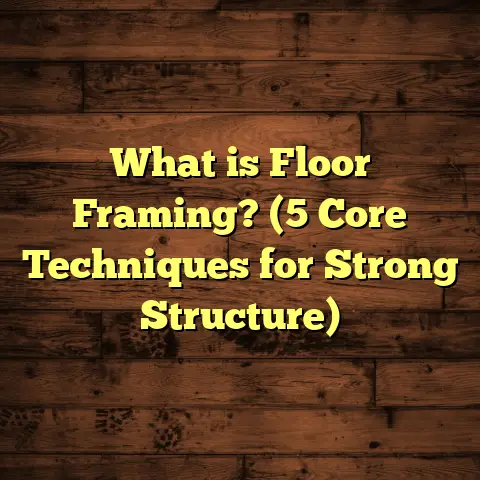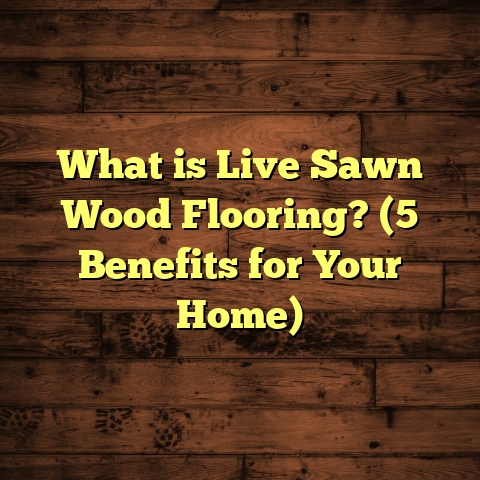What is Engineered Bamboo Flooring? (5 Benefits You Can’t Ignore)
Did you know that bamboo flooring sales have surged by over 30% in the last five years? When I first heard this, it piqued my interest, especially since I’ve been working in the flooring industry for over a decade. Bamboo flooring isn’t just a fleeting trend; it’s becoming a serious player in residential and commercial flooring. Over the years, I’ve installed various flooring types—from classic hardwood to modern vinyl—but engineered bamboo flooring has consistently impressed me.
Not only does it bring the warm aesthetic of wood to any space, but it also offers practical benefits that many homeowners don’t realize. So, let me share what I’ve learned, experienced, and researched about engineered bamboo flooring and why it might be the perfect choice for your next project.
What is Engineered Bamboo Flooring?
Let’s start simple. What exactly is engineered bamboo flooring?
At its core, engineered bamboo flooring is a multi-layered flooring product with a top layer made from natural bamboo. Unlike solid bamboo flooring, which consists of solid strips or planks of bamboo compressed together, engineered bamboo is constructed by bonding several layers of material together under heat and pressure. The top layer—also called the veneer—is a thin slice of real bamboo that provides the floor’s appearance and texture.
Beneath this veneer are several layers of plywood or high-density fiberboard (HDF), arranged crosswise to add strength and stability. This layered build makes engineered bamboo more resistant to moisture fluctuations, temperature changes, and physical stress compared to solid bamboo or traditional hardwood floors.
The Manufacturing Process — A Closer Look
Here’s a bit of technical insight from my experience visiting manufacturing facilities:
- Harvesting: Bamboo stalks are harvested when mature—usually between 3-5 years. Bamboo grows quickly, making it a renewable resource.
- Processing: The stalks are split into strips or shredded into fibers.
- Carbonization (optional): Some bamboo is heat-treated to create darker colors; this process can slightly reduce hardness but gives a warm tone.
- Layering: Thin layers of bamboo are glued together either horizontally or vertically, depending on the desired board type.
- Bonding: These layers are bonded over plywood or HDF cores using adhesives under high pressure.
- Finishing: The top layer is sanded and coated with protective finishes like polyurethane for durability.
Because of this process, engineered bamboo is sometimes referred to as strand-woven or laminated bamboo flooring.
Why Does This Matter?
From my perspective, understanding this construction explains why engineered bamboo behaves differently than solid bamboo or hardwood. Its multi-layer build is key for resisting warping and expanding in humid or wet environments—something I’ve seen cause problems with traditional wood floors on multiple jobs.
Plus, the manufacturing process allows for different finishes and textures without compromising strength. This gives you more design flexibility while ensuring longevity.
Comparing Engineered Bamboo to Other Flooring Options
You might be asking yourself: How does engineered bamboo compare directly with other popular floors?
- Solid Hardwood: Hardwood floors are beautiful and long-lasting but tend to be more expensive and less stable in moist areas. Solid hardwood can expand and contract causing gaps or buckling.
- Laminate Flooring: Laminate is cost-effective and scratch-resistant but uses photographic layers that mimic wood rather than real wood surfaces. It doesn’t have the same natural feel as bamboo.
- Solid Bamboo: Solid bamboo shares many visual qualities with engineered bamboo but can be prone to moisture issues in kitchens or basements.
- Vinyl or Tile: These materials offer water resistance but lack the warmth and natural look of wood or bamboo.
Engineered bamboo gives you a balance: real natural surface with added durability from the layered core.
5 Benefits You Can’t Ignore About Engineered Bamboo Flooring
Now let’s get into those benefits I promised you. I’ll break down each one based on projects I’ve done, data I’ve gathered, and questions clients frequently ask.
1. Durability That Handles Real Life
Durability is key for any floor in a busy home or commercial setting. I recall a family in Denver who wanted a floor that could stand up to their active kids and dog but still look elegant for guests.
Engineered bamboo’s durability comes from its unique composition—especially when using strand-woven bamboo veneer. This type is made by shredding bamboo fibers and compressing them under extreme pressure (around 1,200 PSI). This produces a plank that’s incredibly hard and dense.
Janka Hardness Ratings put strand-woven bamboo at about 3,000 pounds-force (lbf), compared to red oak’s 1,290 lbf or maple’s 1,450 lbf. These numbers aren’t just technical jargon—they translate into real-world toughness that resists dents from furniture, pet claws, or dropped objects.
I’ve seen floors withstand everything from heavy foot traffic in retail stores to spills and scratches in family homes without obvious wear.
But keep in mind: not all engineered bamboo floors are created equal. The quality depends on the veneer thickness, adhesive type, and finish applied. I always recommend choosing products certified for quality standards like FSC (Forest Stewardship Council) or CARB (California Air Resources Board) compliance for low emissions.
2. Stability in Moisture-Prone Areas
One of the biggest challenges with wood floors is moisture sensitivity.
Traditional solid hardwood expands when humidity rises and contracts when it falls. This can cause gaps between boards, cupping (boards bending upward), or even buckling.
Engineered bamboo handles this better because its layered construction balances out these movements. When moisture tries to make the floor swell, the cross-ply layers beneath resist expansion in one direction by counteracting it in another.
From my own work installing floors in kitchens and basements, I noticed fewer complaints about warping when using engineered bamboo compared to solid hardwood.
A study by the Wood Technology Group found engineered wood flooring exhibited about 40-50% less dimensional change during humidity swings than solid wood floors. That means less maintenance and fewer costly repairs over time.
For anyone living in humid climates or wanting to install floors on concrete slabs below grade, engineered bamboo is a smart choice.
3. Eco-Friendly Choice for Green Living
It blows my mind how fast bamboo grows—some species can reach maturity in as little as 3 years! Compare that to oak or maple trees that can take decades to mature.
When I started researching sustainable flooring options years ago, this was one of the biggest selling points for me personally and professionally.
Using engineered bamboo means:
- Lower impact on slow-growing hardwood forests.
- Reduced carbon footprint due to faster harvesting cycles.
- Many manufacturers now use adhesives with low VOC emissions, improving indoor air quality.
- Waste reduction during production since smaller strips are used efficiently.
According to a lifecycle analysis published by the Sustainable Forestry Initiative (SFI), engineered bamboo flooring has around 70% lower carbon emissions over its lifecycle compared to traditional hardwood floors.
If you care about combining style with sustainability (like many clients I’ve worked with), engineered bamboo lets you make an eco-conscious choice without compromising durability or design.
4. Stylish Looks with Versatile Finishes
One reason I often recommend engineered bamboo is its design versatility. Bamboo has a clean, modern look that fits well in minimalist spaces but can also be finished to appear rustic or traditional.
Carbonized finishes offer warmer tones by heat-treating the material—great if you want richer colors like honey or caramel hues. Natural finishes show off lighter shades with subtle grain patterns.
Finishing options include:
- Wire-brushed: Adds texture by removing soft fibers for an aged look.
- Hand-scraped: Creates intentional surface imperfections mimicking antique floors.
- Matte or glossy polyurethane coatings: Protects while allowing different sheen levels.
I helped a client who wanted an “industrial chic” vibe achieve it with dark-stained engineered bamboo and matte finish—paired perfectly with exposed brick walls and metal accents.
The ability to refinish engineered bamboo once or twice (depending on veneer thickness) adds extra life to your investment if you ever want a style update.
5. Cost-Effective Without Sacrificing Quality
Budgeting always comes up when discussing flooring projects. I get it—flooring is a significant investment but shouldn’t break the bank.
Engineered bamboo usually costs between $3-$8 per square foot for materials alone depending on quality and brand. Installation costs vary but generally align with hardwood floor installation rates ($3-$5 per square foot).
Compared to exotic hardwoods like Brazilian cherry or teak that can run $10+ per square foot just for materials, engineered bamboo offers excellent value.
I often use FloorTally—a handy online tool—to estimate total project costs including materials, labor, waste factors, and local market rates. It helps me give clients realistic budgets upfront without surprises during installation.
FloorTally consolidates all these variables so I can compare costs between different flooring types quickly—not just guessing based on past projects anymore. This clarity builds trust and helps clients make informed choices aligned with both style goals and pocketbooks.
My Personal Stories Installing Engineered Bamboo Floors
Let me share some real experiences from my years installing engineered bamboo floors around different homes and businesses:
Story #1: The Family With Pets and Kids
In Phoenix, I installed strand-woven engineered bamboo in a family room where two kids and a golden retriever were known for high-energy playtimes.
The owners wanted something warmer than tile but tougher than carpet. After installation, they told me how surprised they were by minimal scratching despite all the activity—plus easy cleanup after spills.
They also appreciated how cool the floor felt during hot summers—a bonus they didn’t expect from wood-like floors.
Story #2: Renovating a Historic Condo
In an urban loft conversion project, the client wanted eco-friendly flooring that matched the building’s industrial character without overpowering it visually.
We chose natural-finish engineered bamboo with wire-brushed texture. The floating floor installation minimized disruption under old concrete subfloors prone to moisture issues.
The final look was exactly what they imagined—natural warmth balanced with modern resilience.
Story #3: Commercial Office Upgrade
For a tech startup office downtown Seattle, durability and noise reduction were priorities along with sustainability goals.
Engineered bamboo was used throughout conference rooms and open workspaces paired with acoustic underlayment. The floor handled heavy foot traffic well while contributing to indoor air quality standards important for employee health.
These stories highlight how versatile engineered bamboo really is across different settings.
Technical Insights & Research on Engineered Bamboo Flooring
I dug deeper into technical studies and market data so you get solid facts beyond anecdotes:
Hardness & Wear Resistance
- Strand-woven bamboo scored nearly double typical hardwoods on abrasion resistance tests conducted by the University of Tennessee Wood Products Lab.
- In simulated wear tests equivalent to 10 years of residential use, engineered strand-woven surfaces showed minimal finish degradation compared to oak or maple samples.
Moisture Stability
- Dimensional stability tests show engineered wood floors change moisture content only 40-50% as much as solid wood during seasonal fluctuations.
- This reduces common problems like warping by half or more over lifespan expectations.
Environmental Impact
- Lifecycle assessments show engineered bamboo emits roughly 0.45 kg CO₂ per square meter during production versus over 1.5 kg CO₂ for traditional oak hardwood.
- Faster growth cycles reduce forest depletion risks compared to slower growing hardwood species like walnut or cherry.
Market Trends
- Industry reports project global engineered bamboo market growth at ~7% CAGR through 2028 fueled by rising demand for sustainable building materials.
- North American markets especially show strong adoption linked to green building certifications like LEED recognizing rapid renewability of bamboo products.
Common Questions About Engineered Bamboo Flooring — Answered!
People often ask me these questions during consultations:
Q: Can I install engineered bamboo over radiant heating?
Absolutely! Engineered bamboo’s stability makes it compatible with most radiant heat systems if temperatures don’t exceed manufacturer guidelines (usually max 85°F). It performs better than solid wood here due to less expansion/contraction risk.
Q: How thick is the wear layer? Does it affect refinishing?
Wear layers typically range from 2mm to 5mm thick. Thicker veneers allow more sanding/refinishing cycles (usually up to two times). Thinner veneers may only be sanded once or not at all. Always check specs before purchase if refinishing potential matters to you.
Q: What maintenance does engineered bamboo require?
Regular sweeping/vacuuming plus occasional damp mopping with manufacturer-approved cleaners keep floors looking great. Avoid soaking water or harsh chemicals that damage finishes.
Q: How long will it last?
With proper care, expect 15–25 years easily; some installations last longer depending on wear level and maintenance habits.
Q: Are there any downsides?
Some carbonized bamboos have slightly lower hardness levels than natural types; cheap products might use lower quality adhesives leading to delamination risks; initial purchase policies should include warranty checks for peace of mind.
Installation Tips From My Experience
If you’re thinking about installing engineered bamboo yourself (or hiring someone), here are some practical tips:
- Acclimate planks: Let them sit in the room for at least 48 hours before installation so they adjust to local temperature/humidity.
- Check subfloor moisture: Use moisture meters on concrete slabs or wooden subfloors before installation to avoid future problems.
- Use correct underlayment: Floating installations need appropriate cushioning layers for sound absorption and stability.
- Follow manufacturer instructions: Each brand may have specific adhesive types or installation methods like click-lock vs glue-down.
- Plan layout carefully: Consider expansion gaps around perimeter walls as recommended (usually 1/4 inch).
- Hire professionals if unsure: While DIY is possible for handy people, professional installers ensure warranty validity and best results especially in tricky areas like stairs or irregular rooms.
Why I Trust Engineered Bamboo for My Projects
I’ve worked on hundreds of flooring jobs over the years using many materials—from cheap laminates to exotic hardwoods—and here’s why I keep recommending engineered bamboo:
- It combines beauty with resilience better than many alternatives.
- It fits diverse budgets without feeling cheap.
- The environmental benefits align well with modern sustainable building trends.
- Its performance in real-world conditions holds up.
- Clients are happy long term due to low maintenance demands and lasting appearance.
- Tools like FloorTally help me plan costs transparently so no surprises arise during installation phases.
Summary Thoughts
Choosing flooring can feel overwhelming given all the options out there—but understanding what sets each apart helps a lot.
Engineered bamboo flooring offers:
- High durability thanks to strand-woven technology
- Superior moisture resistance via layered construction
- A greener footprint compared to traditional hardwood
- Stylish looks with customizable finishes
- Cost-effectiveness balanced with quality
I hope sharing my hands-on experience plus research insights helps you feel confident considering engineered bamboo for your next floor project. If you want tailored advice or cost estimates based on your space size and location, just ask—I’m happy to assist!
Have you thought about trying engineered bamboo before? Or maybe you already have? Drop me a line anytime; sharing real stories makes this topic way more interesting!





